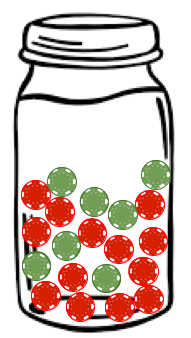Table of Contents |
In this tutorial, you're going to learn about the general "and" probability formula for dependent events. In a separate tutorial, we talked about "and" probability for independent events, which had a special multiplication rule where you simply multiplied the probability of each event together. This, on the other hand, has a general multiplication rule.
EXAMPLE
Suppose there's a famous television show called "Go For Broke.” On the show, a person gets to roll a die to determine which jar they're going to draw a colored chip from. If the chip is green, they will win a prize, and if the chip is red, they won’t win anything.

|

|
|
Roll an Even: Pick from Jar A |
Roll an Odd: Pick from Jar B |





Recall that when two events are independent, this really means that knowing the outcome of the first event, A, doesn't change the probability of the second event (B).
So, for independent events, we can say the probability that B occurs given that we know that A happened is the same as just the probability of B--whether or not we knew A was happening. In other words, A has no effect on the probability of B.

What does that mean within the "and" probability formula? That means the probability of A and B is equal to the probability of A times the probability of B given A, which we know this by the general multiplication rule.
But for independent events, probability of B given A is the same as the probability of B. This formula looks familiar. That's the special multiplication rule for independent events. The special multiplication rule is a special version of the general multiplication rule.

Source: THIS TUTORIAL WAS AUTHORED BY JONATHAN OSTERS FOR SOPHIA LEARNING. PLEASE SEE OUR TERMS OF USE.